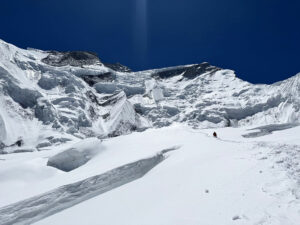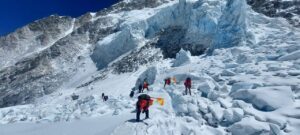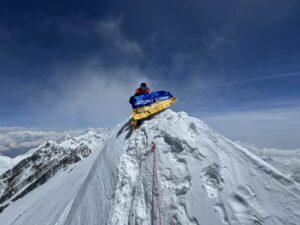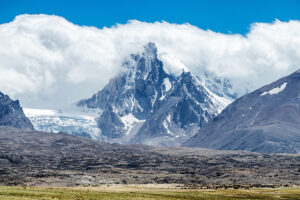The man who wants to ski down Annapurna, the return of The Everest Sprinter and the Old Man of Dhaulagiri, and more spring expeditions to the Himalaya.
Yoric Vion, a mountain guide and ski instructor from Courmayeur, Italy has joined the quest for Annapurna. He intends to use no supplementary oxygen and “no assistance”.
Vion will pitch his own tents at three higher camps, acclimatize, then return to Base Camp and launch his summit push as soon as the weather permits. While this is a rather self-sufficient way of climbing, Vion will use the mountain’s normal North Side route, so any wish of solitude (or true independence) is futile. There will be about 50 people there, progressing on previously fixed ropes via a broken trail.

Yoric Vion, ready to climb and then ski down Annapurna. Photo: Yoric Vion
Vion may, however, carve his own personal line on the descent, since he is considering skiing down from the summit: a remarkable challenge, rarely attempted, and with a sad background in French climbing history.
In 1979, Ives Morin perished while attempting to ski from the top of Annapurna. His jumar got stuck while rappelling a very steep section and with the skis on, he couldn’t extricate himself. (Read the report in the AAC bulletin here.) Andrej and Davo Karnicar were more successful in 1995, although the point from which Davo started skiing is contentious. The latest attempt was in 2018: Russians Anton Pugovkin and Vitalij Lazo billed it as part of their Death Zone Freeride, but they eventually gave up because of dangerous conditions.
Vion learned to climb at home in the Alps — Courmayeur is just a cable car ride from Chamonix — then progressed to higher peaks in Central Asia. This will be his first Himalayan 8,000m experience.
The Everest Sprinter
Marc Batard, formerly known as The Everest Sprinter, is also on his way to Base Camp. Batard gained the nickname in 1988 when he broke the record for the fastest Everest ascent without supplementary oxygen (22.5 hours). He wants to celebrate his 70th birthday on Everest next year, bidding farewell to his climbing career in grand style, and Annapurna is his final preparatory climb.
So far, the odds have seemed against him in several ways: First, the COVID pandemic halted his training and plans. Then, his climbing partner and assistant during the climb was supposed to be his old friend, Ali Sadpara.

Muhammad Ali Sadpara and Marc Batard in K2 Base Camp this past winter. Photo: Today24.news
This past December, Batard even trekked to K2 Base Camp in order to visit the Sadparas. He returned home in the helicopter together with the Nepali summiters and heard about his friend’s disappearance some weeks later.
In Base Camp, he also met Nirmal Purja again (they knew each other from Aconcagua), and Purja’s company will handle Batard’s logistics. According to Mountainblog, Batard asked Sajid Sadpara if he was interested in taking the place of his father on Annapurna. However, friends of the Sadpara family confirm that Sajid will not go to Nepal this spring. Instead, Batard has enlisted Pasang Nuru Sherpa to help him on the climb.
Dhaulagiri Teams Acclimatizing
Steffi Troguet and Jonatan García continue their acclimatization trek up the Khumbu Valley. As usual, they spent a rest day in Namche Bazaar to visit Dingboche, on its hill at 4,300m. On the way, they also walked up Nangkartsang Peak (5,083m) for an overview and a bit more altitude before continuing to the village in the afternoon.

Stefi Troguet on a very dry year. Photo: Stefi Troguet
The route up the Khumbu Valley to Everest Base Camp at 5,300m features comfortable accommodations, well-kept trails, great views, and a reasonably high altitude. This makes it a popular spot to acclimatize, even if the goal is in a different part of Nepal, as is the case with Troguet, who is heading for Dhaulagiri.
En route, most Everest BC trekkers walk up Kala Pattar (a shoulder of Pumori) for the best views of the Everest-Lhotse-Nuptse group. It also lets them reach 5,644m with just hiking boots and walking poles. Others opt to climb lesser peaks in the area but must carry tools for glacier travel, such as crampons, an ice ax, ropes, and a climbing harness. These include Imja Tse (Island peak) at 6,189m and Lobuche at 6,119m.
Horia Colibasanu and Marius Gane received the news that their quarantine has ended a little prematurely — last week’s pending law for vaccinated visitors like themselves may be coming into effect. They wasted no time shedding Kathmandu for the mountains and are currently trekking in the Khumbu region. Fellow team member Peter Hamor left on his own acclimatization trek some days earlier.
He’s back…
The old man of the mountains, Spain’s Carlos Soria, is back to attempt Dhaulagiri for the 12th time. At 82, Soria remains determined to finish his 14×8000 project, no matter how many times it takes. His chief goal, he says, is not to become the oldest summiter of several 8,000m peaks, but to keep his unblemished record that “after more than 60 years of climbing in the Himalaya, I have never had to be rescued nor been frostbitten.”

An institution on Dhaulagiri, Carlos Soria returns for his 12th attempt at age 82. Photo: El Correo
Besides Dhaulagiri, Soria also needs to summit the main peak of Shishapangma. Previously, he stopped at the central summit, 8,008m. Soria is climbing with Seven Summit Treks, accompanied by Sito Carcavilla and Luis Miguel Lopez. He flies to Nepal next week and may head into the mountains immediately if the new no-quarantine law comes into effect by then. Despite Spain’s (very) slow vaccination program, Soria’s age allowed him to get jabbed just in time for the expedition.






